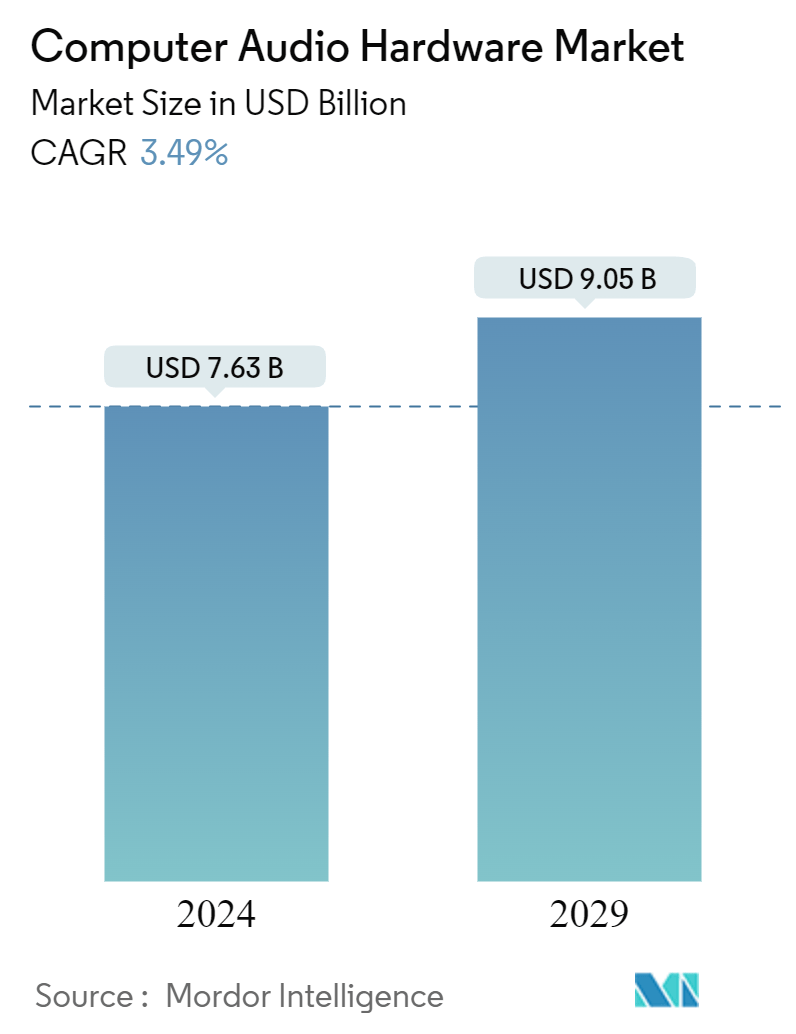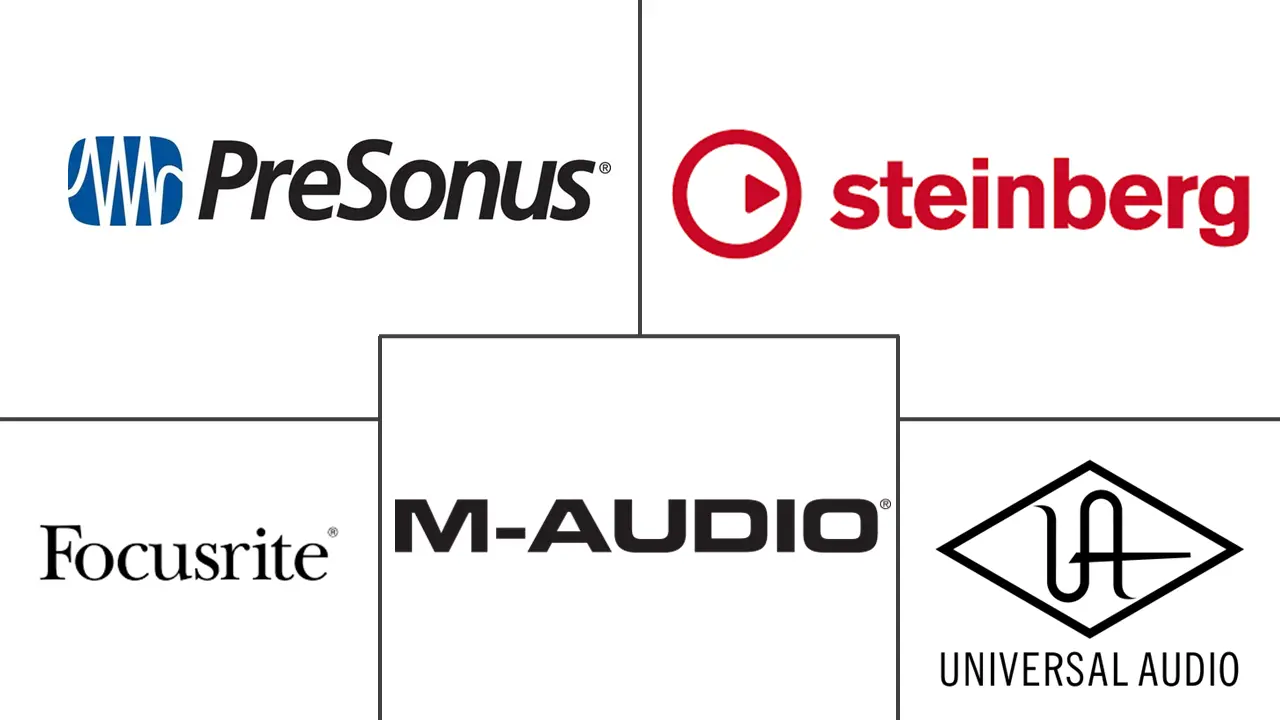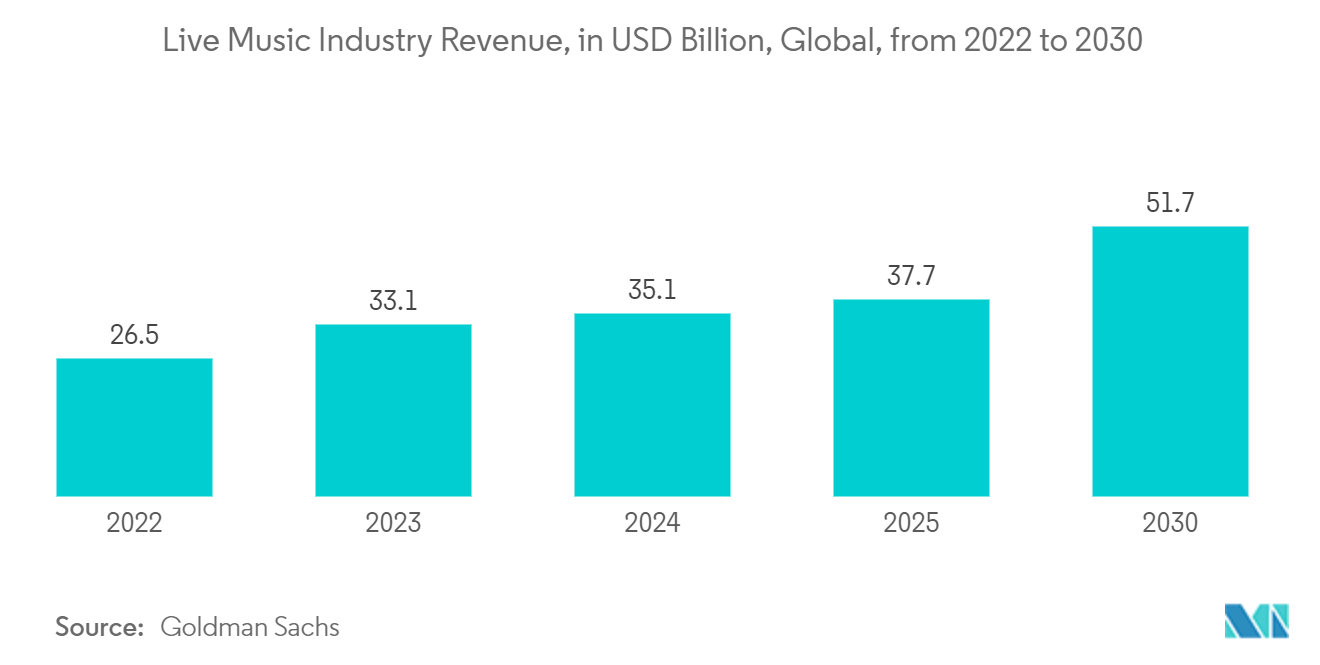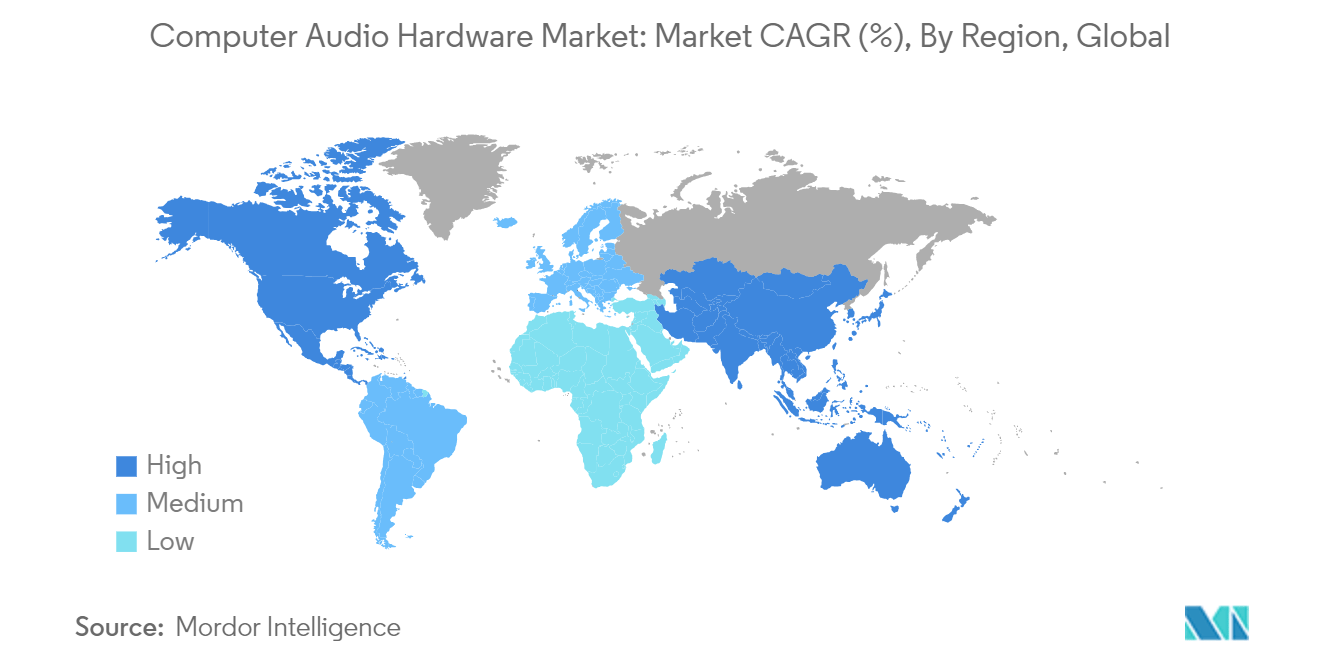Computer Audio Hardware Market Size

| Study Period | 2019 - 2029 |
| Market Size (2024) | USD 7.63 Billion |
| Market Size (2029) | USD 9.05 Billion |
| CAGR (2024 - 2029) | 3.49 % |
| Fastest Growing Market | Asia Pacific |
| Largest Market | North America |
Major Players
*Disclaimer: Major Players sorted in no particular order |
Computer Audio Hardware Market Analysis
The Computer Audio Hardware Market size is estimated at USD 7.63 billion in 2024, and is expected to reach USD 9.05 billion by 2029, growing at a CAGR of 3.49% during the forecast period (2024-2029).
- In the professional audio industry, spanning live music events, recording studios, and broadcast productions, there's an increasing trend of seamlessly integrating computers into the audio workflow. Computers now handle many tasks, from digital audio workstations (DAWs) and audio signal processing to mixing and recording. This computer integration in professional audio setups has spurred a notable demand for high-quality audio interfaces linking these computers with other audio equipment.
- Professional audio performances prioritize top-tier audio quality, emphasizing low latency and minimal signal degradation. Audio interfaces are pivotal, ensuring the computer's audio signal is captured, processed, and directed to equipment like mixing consoles, amplifiers, and speakers without sacrificing quality. Thus, audio engineers and musicians seek interfaces that promise pristine audio, swift latency, and versatile connectivity to align with their rigorous workflows.
- The rise of powerful digital audio workstations (DAWs) and sophisticated audio processing software has catalyzed the shift towards computer-centric audio solutions in professional realms. These software tools, in turn, necessitate high-performance audio interfaces for effective signal capture, processing, and monitoring. As DAWs and audio software capabilities expand, so does the demand for advanced, versatile audio interfaces to keep pace with these developments.
- Rapid technological advancements define the computer audio hardware industry, with manufacturers frequently introducing new features, capabilities, and form factors. Consequently, product life cycles have shortened, compelling manufacturers to consistently update and refresh their offerings to align with evolving market demands and tech trends. These abbreviated life cycles pose challenges for manufacturers, making it difficult to effectively plan and manage production processes in response to swift market changes.
- A declining inflation rate is poised to have a multifaceted impact on the computer audio hardware market. This influence hinges on several elements, such as the broader economic landscape, consumer sentiment, and the diverse products and pricing tiers within the market. Firms that provide distinctive features, superior sound quality, or cutting-edge designs are expected to be more resilient against price sensitivity and competitive pressures. Strategic marketing and promotional efforts can play a pivotal role in drawing consumers' attention and emphasizing the worth of premium-priced audio hardware. Furthermore, well-established brands boasting robust brand loyalty might be insulated from price-driven competition.
Computer Audio Hardware Market Trends
Professional/Corporate Segment is Expected to Hold Significant Market Share
- Businesses and enterprises increasingly prioritize high-fidelity audio for video conferencing, webinars, online training, and multimedia presentations. Similarly, in the media and entertainment sector, audio professionals at recording studios, post-production facilities, and broadcast stations depend on specialized audio interfaces, microphones, and monitoring equipment to guarantee top-notch audio capture and mixing. This underscores the importance of clear and dependable audio in corporate and enterprise settings.
- As remote work becomes the norm, the reliance on virtual meetings has intensified, underscoring the need for clear and dependable audio. Consequently, a heightened demand for headsets, webcams with integrated microphones, and other audio gear tailored for home offices has been heightened. Recognizing the pivotal role of top-notch audio in collaboration tools, many have turned to professional-grade audio equipment. This includes conference room systems and speakerphones, ensuring crystal-clear communication for all participants in virtual meetings.
- Live music performances depend on advanced audio equipment for exceptional sound quality and fidelity. Professionals in the live music industry, including sound engineers, musicians, and production crews, utilize top-tier audio interfaces, microphones, mixers, and PA systems. This ensures audiences enjoy an immersive and captivating experience; furthermore, the industry's appetite for high-performance audio hardware fuels continuous innovation in computer audio technology. A recent study from Goldman Sachs for the global music industry revealed that revenues from live music events surged by 25% in 2023, exceeding USD 33 billion. It is expected that revenues will exceed USD 50 billion by the close of 2030.
- Manufacturers are advancing computer audio hardware, incorporating noise cancellation, spatial audio, and high-resolution audio support. These premium features hold significant value in professional and corporate environments, where audio quality is paramount. As these advanced audio solutions become more accessible and affordable, their adoption in professional and enterprise segments is surging.

North America is Expected to Hold Significant Market Share
- North America, with the United States at its forefront, hosts numerous leading technology firms and innovation hubs, notably California's Silicon Valley. These centers draw a dense population of tech professionals, content creators, and media/entertainment firms, all relying on top-tier computer audio hardware. This concentration of tech-centric industries in North America amplifies the demand for sophisticated computer audio hardware solutions.
- Further, its expansive, tech-oriented consumer base actively participates in diverse multimedia and content creation endeavors, including video production, music recording, podcasting, and streaming. Both professional and prosumer consumers are keen to invest in premium computer audio hardware to elevate their creative processes and content production. As these multimedia pursuits gain traction in North America, the appetite for computer audio hardware continues to surge.
- The region's well-established distribution channels, encompassing retail stores, e-commerce platforms, and specialized audio equipment dealers, ensure easy access to computer audio hardware products. Major audio brands have solidified their presence in North America, bolstering their market penetration and brand recognition through dedicated sales, marketing, and customer support. This combination of robust distribution and strong brand presence cements North America's computer audio hardware market dominance.
- North America has a history of being at the forefront of adopting emerging audio technologies, from high-resolution audio to wireless solutions. This trend fuels a demand for advanced computer audio hardware that embraces these innovations, reinforcing North America's leading position in the market.

Computer Audio Hardware Industry Overview
The computer audio hardware market is fiercely competitive, with numerous companies providing similar products. This competition often results in price wars and pressures on profit margins. To stay ahead, companies diversify their product offerings while maintaining a reasonable price range. Some of the significant players include PreSonus Audio Electronics, Inc., Steinberg, Focusrite PLC, M-Audio, and Universal Audio.
- In May 2024, PreSonus Audio Electronics Inc. unveiled its latest line of Quantum Audio Interfaces. These USB-C audio interfaces, available in four distinct models: Quantum ES 2, ES 4, HD 2, and HD 8, boast features like the all-new MAX-HD mic preamps, high-quality low-noise converters, custom low-latency drivers, and front-facing instrument inputs developed in collaboration with Fender. The Quantum series stands out as the premier recording interface for preferred digital audio workstations (DAW), offering an impressive array of features such as Auto Gain, Loopback, Reamping, and Universal Control software.
- In January 2024, Steinberg unveiled its latest IXO series of USB audio interfaces. The IXO family, which includes the IXO12 and IXO22 models, along with the IXO Podcast Pack and IXO Recording Pack bundles, offers a highly portable solution for recording, podcasting, and streaming across Windows, Mac, and iOS platforms. The newly introduced IXO12 and IXO22 interfaces, designed for ultra-portability, come equipped with two inputs and outputs, support for 24-bit/192 kHz audio, hardware-based latency-free input monitoring, and high-speed USB 2.0 connectivity via USB-C.
Computer Audio Hardware Market Leaders
-
PreSonus Audio Electronics, Inc.
-
Focusrite PLC
-
M-Audio
-
Universal Audio
-
Steinberg Media Technologies GmbH
*Disclaimer: Major Players sorted in no particular order

Computer Audio Hardware Market News
- July 2024 - UK-based Prism Sound partnered with Planeta Analogico in Argentina, entrusting the company with its audio interface lineup. This includes the robust Dream ADA-128, a modular multichannel converter. This collaboration aims to enhance their customers' access to top-tier professional converters, emphasizing sound quality.
- January 2024 - Yamaha Corporation teamed up with Elgato, a specialist in audiovisual technology for content creators. Yamaha's Creator & Consumer Audio Division and Elgato are crafting a software plugin that connects Yamaha's audio interfaces, mixers, and other offerings with Elgato’s Stream Deck controllers. This collaboration aims to bolster the range of products and services available to creators across diverse domains, including music, video production, and live streaming.
Computer Audio Hardware Market Report - Table of Contents
1. INTRODUCTION
- 1.1 Study Assumptions and Market Definition
- 1.2 Scope of the Study
2. RESEARCH METHODOLOGY
3. EXECUTIVE SUMMARY
4. MARKET INSIGHTS
- 4.1 Market Overview
-
4.2 Industry Attractiveness - Porter's Five Forces Analysis
- 4.2.1 Threat of New Entrants
- 4.2.2 Bargaining Power of Buyers
- 4.2.3 Bargaining Power of Suppliers
- 4.2.4 Threat of Substitute Products
- 4.2.5 Intensity of Competitive Rivalry
- 4.3 Industry Value Chain Analysis
- 4.4 An Assessment of Macroeconomic Trends on the Market
5. MARKET DYNAMICS
-
5.1 Market Drivers
- 5.1.1 Increasing Demand for Audio Interfaces in Professional Audio Performances using Computers
- 5.1.2 Growing Interest towards Content Creation
-
5.2 Market Restraint
- 5.2.1 Rapid Technological Changes Leads to Create Manufacturing Challenges
6. MARKET SEGMENTATION
-
6.1 By Type
- 6.1.1 Audio Interfaces and Systems
- 6.1.2 AD/DA Converters
- 6.1.3 DSP Accelerators
- 6.1.4 Format Converters
- 6.1.5 Wordclock and Synchronization
- 6.1.6 I/O and Expansion Modules
-
6.2 By End-User Industry
- 6.2.1 Consumer
- 6.2.2 Professional/Corporate
-
6.3 By Geography***
- 6.3.1 North America
- 6.3.2 Europe
- 6.3.3 Asia
- 6.3.4 Australia and New Zealand
- 6.3.5 Latin America
- 6.3.6 Middle East and Africa
7. COMPETITIVE LANDSCAPE
-
7.1 Company Profiles*
- 7.1.1 Focusrite PLC
- 7.1.2 M-Audio
- 7.1.3 Universal Audio
- 7.1.4 Behringer
- 7.1.5 Avid Technology, Inc.
- 7.1.6 PreSonus Audio Electronics, Inc.
- 7.1.7 Steinberg Media Technologies GmbH
- 7.1.8 Georg Neumann GmbH
- 7.1.9 Studio Technologies Inc.
- 7.1.10 MOTU, Inc.
- 7.1.11 Prism Sound (Audio Squadron Ltd.)
- 7.1.12 Yamaha Corporation
- 7.1.13 Audient Ltd.
8. INVESTMENT ANALYSIS
9. FUTURE OF THE MARKET
** Subject To AvailablityComputer Audio Hardware Industry Segmentation
Computer audio hardware encompasses the physical components and devices responsible for a computer's sound input, output, and processing. These hardware elements are crucial in producing, capturing, and managing audio signals. The study monitors revenue from hardware component sales across various end-user industries. It also examines growth trends, macroeconomic influences, and the products and strategies key vendors offer.
The computer audio hardware market is segmented by type (audio interface and systems, AD/DA converters, DSP accelerators, format converters, wordclock and synchronisation, and I/O and expansion modules), end-user industry (consumer and professional/corporate), and geography (North America, Europe, Asia, Australia and New Zealand, Latin America, and Middle East and Africa). The market sizes and forecasts are provided in terms of value (USD) for all the above segments.
| By Type | Audio Interfaces and Systems |
| AD/DA Converters | |
| DSP Accelerators | |
| Format Converters | |
| Wordclock and Synchronization | |
| I/O and Expansion Modules | |
| By End-User Industry | Consumer |
| Professional/Corporate | |
| By Geography*** | North America |
| Europe | |
| Asia | |
| Australia and New Zealand | |
| Latin America | |
| Middle East and Africa |
Computer Audio Hardware Market Research FAQs
How big is the Computer Audio Hardware Market?
The Computer Audio Hardware Market size is expected to reach USD 7.63 billion in 2024 and grow at a CAGR of 3.49% to reach USD 9.05 billion by 2029.
What is the current Computer Audio Hardware Market size?
In 2024, the Computer Audio Hardware Market size is expected to reach USD 7.63 billion.
Who are the key players in Computer Audio Hardware Market?
PreSonus Audio Electronics, Inc., Focusrite PLC, M-Audio, Universal Audio and Steinberg Media Technologies GmbH are the major companies operating in the Computer Audio Hardware Market.
Which is the fastest growing region in Computer Audio Hardware Market?
Asia Pacific is estimated to grow at the highest CAGR over the forecast period (2024-2029).
Which region has the biggest share in Computer Audio Hardware Market?
In 2024, the North America accounts for the largest market share in Computer Audio Hardware Market.
What years does this Computer Audio Hardware Market cover, and what was the market size in 2023?
In 2023, the Computer Audio Hardware Market size was estimated at USD 7.36 billion. The report covers the Computer Audio Hardware Market historical market size for years: 2019, 2020, 2021, 2022 and 2023. The report also forecasts the Computer Audio Hardware Market size for years: 2024, 2025, 2026, 2027, 2028 and 2029.
Computer Audio Hardware Industry Report
Statistics for the 2024 Computer Audio Hardware market share, size and revenue growth rate, created by Mordor Intelligence™ Industry Reports. Computer Audio Hardware analysis includes a market forecast outlook for 2024 to 2029 and historical overview. Get a sample of this industry analysis as a free report PDF download.



